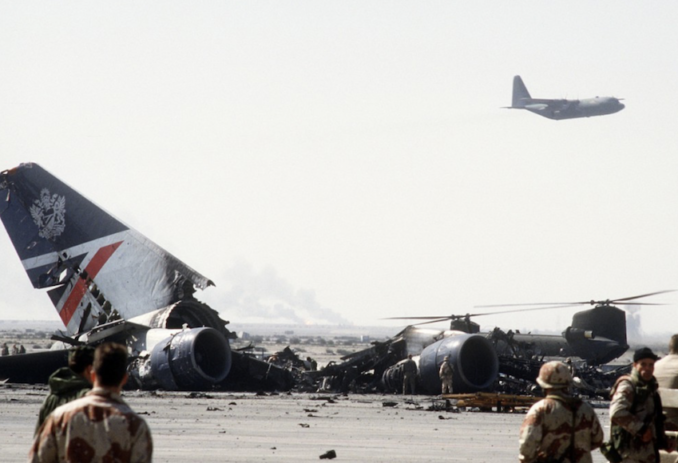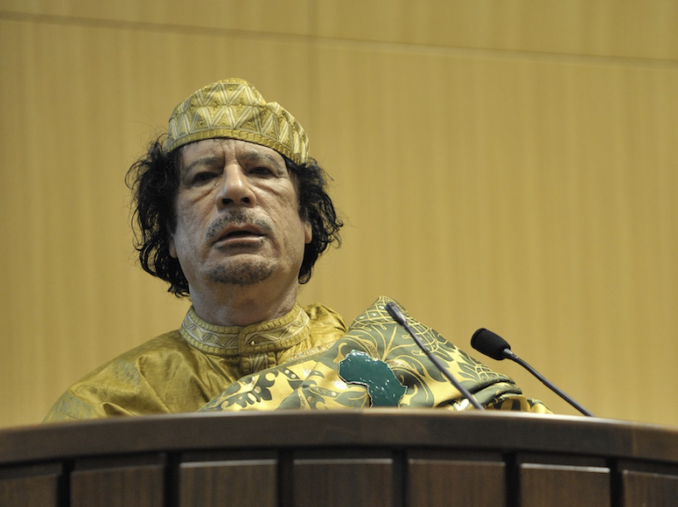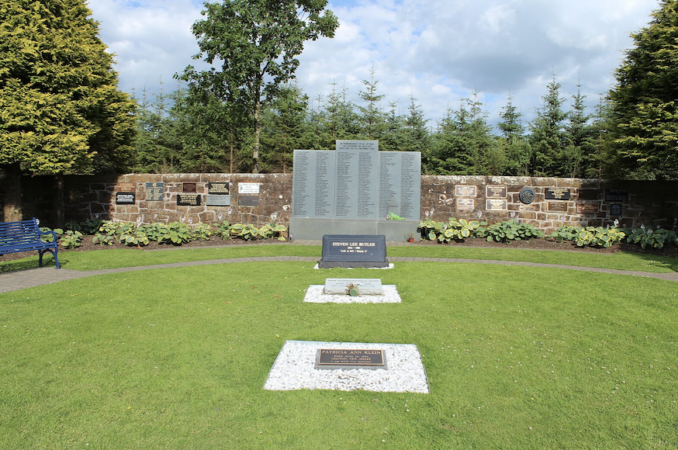As we make our way back from an enjoyable day trip by train to Edinburgh, Mrs AWS and I have pause for thought as we pass through Lockerbie, scene of the 1988 bombing which claimed 270 lives. Syria’s thwarted bomb attack on El Al Flight 016, and the USS Vincennes’ shooting down of Iran Air Flight 655 in July 1988, pointed suspicion towards a Syria-Iran axis to the point of individual suspects being named. However, the tectonic plates of world diplomacy shifted on August 2nd 1990. On the fateful Thursday, Saddam Hussein invaded Kuwait, taking possession of disputed oil fields and setting off a chain of events leading to Gulf War I.

Aircraft at Kuwait Airport during the Iraqi invasion,
US DoD – Public domain
Syria
Under President Hafez al-Assad, the father of the present-day president, Bashar al-Assad, Syria joined the U.S.-led coalition to liberate Kuwait. With a land border with Iraq and Israel, Syria became an important player in the conflict. Different factions of the Ba’ath Party ruled both Syria and Iraq, and the two country’s relationship had been characterised by intense competition and ideological rifts. Wary of Saddam Hussein’s expansionist ambitions and a long-standing rivalry with their neighbour, by joining the coalition, Syria saw an opportunity to weaken Saddam’s regime and regional influence, thereby consolidating its position in the Middle East.
Aligning with the U.S. and its allies presented Syria with an opportunity to break out of its international isolation. Throughout the 1980s, Syria had been perceived as a pariah state due to its support for various militant groups and its confrontational stance towards the West. Participation in the coalition allowed Syria to rebrand itself as a cooperative and responsible member of the international community. This shift had the potential to unlock economic aid and diplomatic support. Sure enough, in November 1990, three months after the invasion and four years after the attempted bombing of El Al Flight 016, diplomatic relations were restored between London and Damascus.
A state of affairs an editorial in the Daily Mirror of the 29th November 1990 headlined as an ‘Act of Treachery.’
‘The restoration of diplomatic links with President Assad’s Syria is an act of folly and treachery we shall live to regret. Folly because although Assad is a temporary ally against his old enemy, Saddam Hussein – and that for self-preservation – he will never be a friend of the West.
‘Treachery because he has sponsored the men behind many of the worst terrorist atrocities and attempted atrocities.
‘Britain broke off diplomatic relations because Syria was involved in the attempt to blow up an Israeli airliner at Heathrow Airport. Assad gives sanctuary to Abu Nidal and Ahmed Jebril, who murdered 270 innocent men, women and children at Lockerbie and he and his Iranian allies slaughtered 241 U.S. Marines and 58 French paratroopers serving in Lebanon as a peacekeeping force.’
During Gulf War I, Syria contributed to the coalition through military means. It sent a contingent of14,500 troops to Saudi Arabia to join the coalition forces. These troops were integrated into the overall command structure and participated in various operations aimed at liberating Kuwait.
Iran
The Iraqi invasion of Kuwait offered Iran a unique opportunity to weaken its primary regional adversary, Saddam Hussein’s regime, without direct involvement. Consequently, Iran tacitly supported efforts to curb Iraq’s power. This support included allowing coalition aircraft to use Iranian airspace for reconnaissance missions and turning a blind eye to the coalition’s military activities in the Persian Gulf. Iranian President Rafsanjani adopted a stance of official neutrality in the conflict as the Tehran regime recovered from the devastating Iran-Iraq War of 1980-1988. A land border with Iraq and a coastline along one side of the Persian Gulf choke point of the Strait of Hormuz rightly encouraged a neutral Iran to expect a thawing of hostility from the United States and Israel.
By the end of the Gulf War I, in February 1991, talk of Syria, Iran, Abu Nidal and Ahmed Jebril was forgotten, with the focus of the Lockerbie investigation turning to Libya.
Different evidence accumulates
Suspicion towards Colonel Gadaffi’s regime included forensic evidence linking the Lockerbie bomb to a specific type of timer, of which only 20 had been made, all sold to Libya. From photographs, a shop owner in Malta identified Abdelbaset al-Megrahi, head of security for Libyan Arab Airlines, as the customer who bought a headscarf forensics placed to a samsonite suitcase containing the bomb. This crucial witness Tony Gauci, a Maltese storekeeper, testified he had sold Megrahi the clothing later found in the wreckage of the aircraft.
The bomb in turn sat within a Toshiba cassette radio player of the RT Bombast series. Investigators at The Royal Armament Research and Development Establishment at Fort Halstead in Kent showed this to be one of a difficult-to-find batch of radio cassette players, 80% of which were exported to Libya. In 1991, indictments were issued against Al Megrahi and another Libyan intelligence officer, Lamin Khalifah Fhimah. When Libya refused to extradite the suspects, the United Nations imposed sanctions. These sanctions restricted Libya’s ability to engage in international trade and finance, causing significant economic hardships.

Muammar Qaddafi, the Libyan chief of state,
Jesse B. Awalt (US Navy) – Public domain CC BY-SA 2.0
Libyan handover
Facing crippling sanctions and diplomatic isolation, Gaddafi’s regime began to reconsider its stance in the mid-1990s. Gaddafi, known for his anti-Western rhetoric and support for various militant groups, started to signal a shift in Libyan foreign policy. A shift driven by pragmatic considerations: the need to revive the Libyan economy, attract foreign investment, and reintegrate Libya into the international community. In 1999, Gaddafi decided to hand over al-Megrahi and Fhimah to stand trial. The agreement was they would be tried in a neutral country, the Netherlands, at an American Air Force base, Camp Zeist, under Scottish law before judges sitting without a jury.
This was part of a broader effort to normalise relations with Western countries, which included abandoning Libya’s development of weapons of mass destruction, disposing of its stockpile of uranium and renouncing terrorism. The simultaneous end of the Cold War reduced the strategic importance of Libya’s alignment with the Soviet bloc and encouraged a reorientation towards the West.
Lockerbie trial and convictions
The trial began in May 2000 at the Scottish Court in the Netherlands. The prosecution’s case referred to the forensic evidence linking the bomb to a specific type of timer. Made by Mebo Telecommunications AG of Zurich, their MST-13 was said to have triggered the bomb. In evidence, Edwin Bollier, co-founder of Mebo, identified a fragment from an MST-13 timer, 20 of which had been delivered to Libya. However, Bollier also claimed similar timers had been sold to East Germany and photographs shown to him by the Scottish police had been from another timer.
Testimonies from various witnesses placed al-Megrahi and Fhimah at key locations where the bomb’s journey began. The bomb had left Malta in unaccompanied luggage which connected with the doomed Pan Am Flight 103 at Heathrow. However, witness Tony Gauci identified al-Megrahi in photographs but struggled to do so in court, while defendant Fhimah showed an alibi in Sweden. In January 2001, the court reached its verdict. Abdelbaset al-Megrahi was found guilty of 270 counts of murder and was sentenced to life imprisonment, with a minimum term of 27 years. Lamin Khalifah Fhimah was acquitted.
The aftermath
Al-Megrahi’s conviction met mixed reactions. While many saw it as a measure of justice for the victims and their families, questions lingered about the robustness of the evidence and the influence of a broader political background. In 2003, Libya accepted responsibility for the bombing and compensated the victims’ families, yet it never admitted direct involvement in the planning or execution of the attack – an ambiguity that fueled ongoing speculation. Al-Megrahi’s defence team maintained his innocence throughout his trial, unsuccessful appeal and subsequent imprisonment, claiming he had been wrongfully convicted based on flawed evidence and political considerations.
In 2007, the Scottish Criminal Cases Review Commission referred the case back to the High Court of Justiciary in Scotland for a second appeal. However, by now al-Megrahi’s health was deteriorating. Two years later, the convicted terrorist, who had been diagnosed with terminal prostate cancer, was released on compassionate grounds in a controversial decision by the Scottish Government. He returned to Libya to a hero’s welcome. He remained there until he died in 2012, meaning the second appeal was never heard.

Lockerbie Air Disaster Memorial,
Billy McCrorie – Licence CC BY-SA 2.0
© Always Worth Saying 2024



